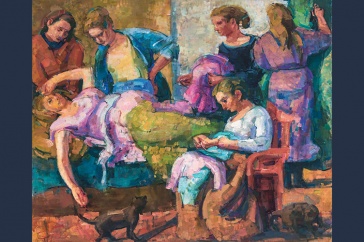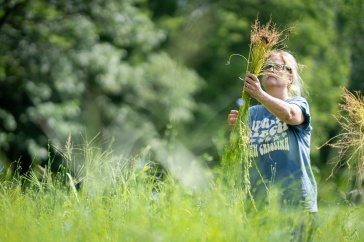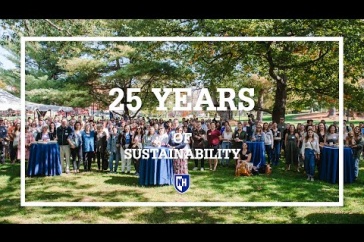
The process of photogammetry used to document an artifact and ready it for creating a 3-D digital image. Courtesy photo.



Archeological sites and artifacts help us understand past cultures and societies; but what happens when they are destroyed or their origins are unknown? This semester, students in assistant professor Ivo van der Graaff’s art history class explored these questions and took a hands-on approach to preserving history.
In ARTS 440A, honors students learned the methods for the digital documentation of artifacts and the ethics of cultural conservation. Students worked with objects donated to the UNH Museum of Art to assess digital tools available to conservators, art historians and archaeologists. In addition, they looked at how photogrammetry, 3-D modeling, virtual reality and digital applications can help preserve our cultural heritage. More specifically, each student received an artifact from the museum to research, photograph and 3-D model. Their research aimed to help museum leadership properly identify each artifact and in turn provided a 3-D printed model and digital record of that object.
“The artifacts chosen for students to analyze were objects with problematic backgrounds,” van der Graaff says. “We looked at how we can document artifacts using digital technology. They got a sense of how technology can help preserve some of the artifacts in the long run and how museums can use technology in outreach. For example, you can put models like these online, so people don’t have to travel to a museum. It can also be used as a pedagogical tool.”
To document each artifact, students used the process of photogrammetry to take multiple pictures surrounding an object, before editing in Photoshop. Then, the photos were uploaded into a program called PhotoScan to stitch together a 3-D image of each object. Finally, students printed their 3-D images using the Art Department’s 3-D printer. They also loaded their 3-D images onto a website called Sketchfab, which allows viewers to look at objects from all angles. Their final projects are posted to their UNH MyPages, where they presented the findings of their research — including place of origin and meaning, van der Graaff says. (See the final project on "Temple Lion" by Faith Farnham and Noor Al-Saad.)
“If the original object were ever to be destroyed, you would have a 3-D record of it,” he says. “Part of the class is assessing the quality of the original object and comparing it to the quality of the 3-D models and determining if it’s worth the effort.”
Julianna Sagliano, a junior B.F.A. photography major and Visual Resource Center fellow, helped students photograph artifacts and assisted them throughout the 3-D modeling process.
“Students have to edit anywhere between 70 and 150 photos. It’s very time-consuming and they have to go through each and every one to prepare them to be placed into the 3-D modeling program,” she says. “I think they enjoyed seeing their models come to life between the 3-D program and 3-D printer. Once their models were printed, they felt relieved that it worked and thrilled that there was something tangible to show for all of the hours they put in to creating the model.”
First-year student Annelise Papinsick, a music major, says she came into the class with no knowledge of the importance of the 3-D modeling process or its significance in preserving history. She says taking photos of her artifact and editing the photos to make the best model involved trial and error — taking too many pictures of the object skews the 3-D model and requires adjustment, she explains. But the most surprising thing she learned in the class related to discussions about how museums display their exhibits; for example, how the way a museum presents objects can affect the way the viewers think about them and their place in history.
“An object presented without its cultural background is sanitized and speaks nothing to its viewers about its importance in the human culture,” Papinsick says. “This is something I had never considered prior to this class.”
Kristina Durocher, director of the UNH Museum of Art, says that it is important for museums to present objects as accurately as possible to the public. The pieces chosen, some of which alumni donated, have an unknown origin and require more accurate dating and geographic information, she says. Creating 3-D models both preserves them digitally and allows others to weigh in on their characteristics.
“One of the benefits of having an accurate model is that you then don’t risk damaging the work of art itself. The less you have to handle it, the safer the object is,” Durocher says. “With the 3-D digital models students created, I was able to share some of the Himalayan art with a colleague at the Rubin Museum of Art in New York City. He can share with his colleagues and scholars can look at all sides, and all angles. Otherwise, someone would have had to come here to do that or we’d have to send things out. It’s a very useful tool more museums will use in future.”
The class itself was associated with this year’s Sidore Lecture Series, “Who Owns the Past?” which spanned the Departments of History; Classics, Humanities and Italian Studies; Anthropology; and Art and Art History. The series featured speakers that have looked at satellite monitoring of archaeological damage and looting in the Syrian Civil War, cultural heritage in conflict zones and loot in U.S museums, to name a few.
Similar processes are increasingly used in archaeology as a way to record sites and objects found in the field, according to van der Graaff, who also participates in archaeological research projects in Italy and is the director of excavations there for the Oplontis Project, a systematic, multidisciplinary study of two ancient Roman villas.
“Our cultural heritage is a component of human history that needs to be preserved,” van der Graaff says. “It’s our journey and our story.”
Meghan Howey Digs Durham
The associate professor of anthropolog, digs for clues to New Hampshire's early — and violent — past on the edge of Great Bay.
<iframe width="300" height="315" src="//www.unh.edu/unhtoday/%3Ca%20href%3D"https://www.youtube.com/embed/1mWsbc4KMqo">https://www.youtube.com/embed/1mWsbc4KMqo" frameborder="0" allow="autoplay; encrypted-media" allowfullscreen></iframe>
-
Written By:
Krysten Godfrey Maddocks '96 | College of Liberal Arts | krysten.godfreymaddocks@unh.edu





















































